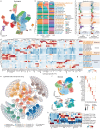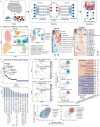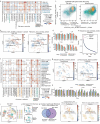A deep learning framework for in silico screening of anticancer drugs at the single-cell level
- PMID: 39872221
- PMCID: PMC11771446
- DOI: 10.1093/nsr/nwae451
A deep learning framework for in silico screening of anticancer drugs at the single-cell level
Abstract
Tumor heterogeneity plays a pivotal role in tumor progression and resistance to clinical treatment. Single-cell RNA sequencing (scRNA-seq) enables us to explore heterogeneity within a cell population and identify rare cell types, thereby improving our design of targeted therapeutic strategies. Here, we use a pan-cancer and pan-tissue single-cell transcriptional landscape to reveal heterogeneous expression patterns within malignant cells, precancerous cells, as well as cancer-associated stromal and endothelial cells. We introduce a deep learning framework named Shennong for in silico screening of anticancer drugs for targeting each of the landscape cell clusters. Utilizing Shennong, we could predict individual cell responses to pharmacologic compounds, evaluate drug candidates' tissue damaging effects, and investigate their corresponding action mechanisms. Prioritized compounds in Shennong's prediction results include FDA-approved drugs currently undergoing clinical trials for new indications, as well as drug candidates reporting anti-tumor activity. Furthermore, the tissue damaging effect prediction aligns with documented injuries and terminated discovery events. This robust and explainable framework has the potential to accelerate the drug discovery process and enhance the accuracy and efficiency of drug screening.
Keywords: drug screening; machine learning; pan-cancer; scRNA-seq; targeted therapy.
© The Author(s) 2024. Published by Oxford University Press on behalf of China Science Publishing & Media Ltd.
Figures






References
LinkOut - more resources
Full Text Sources
